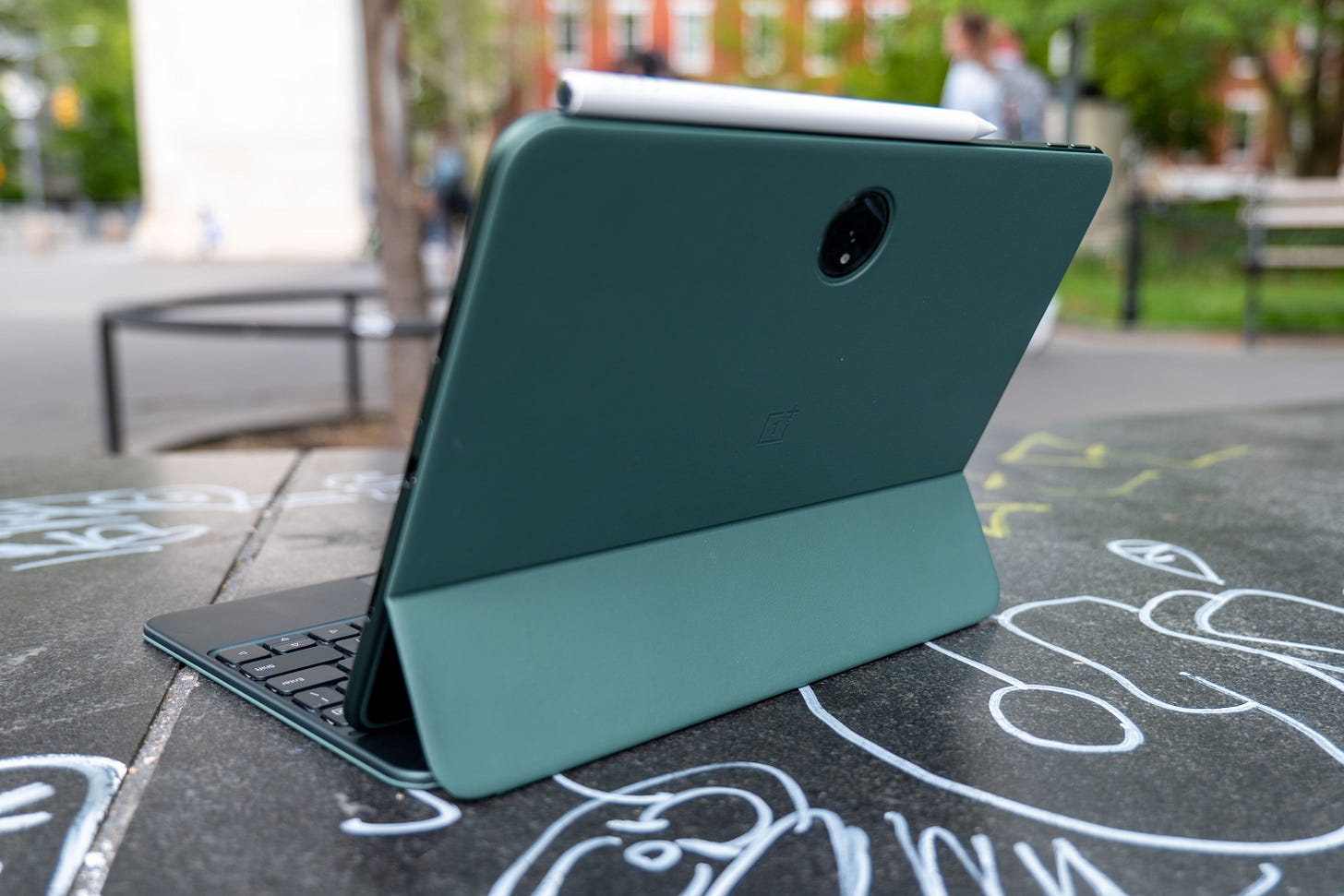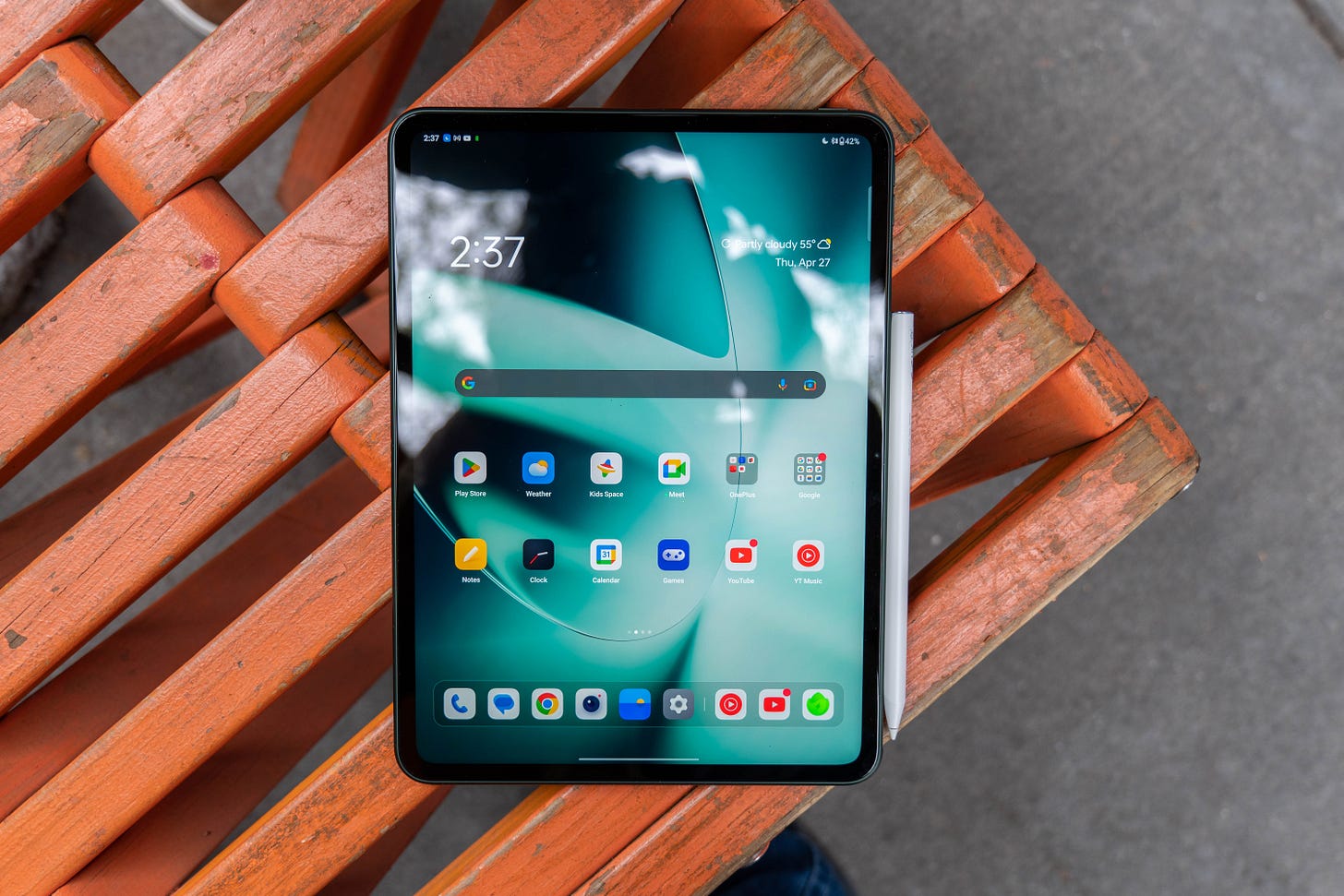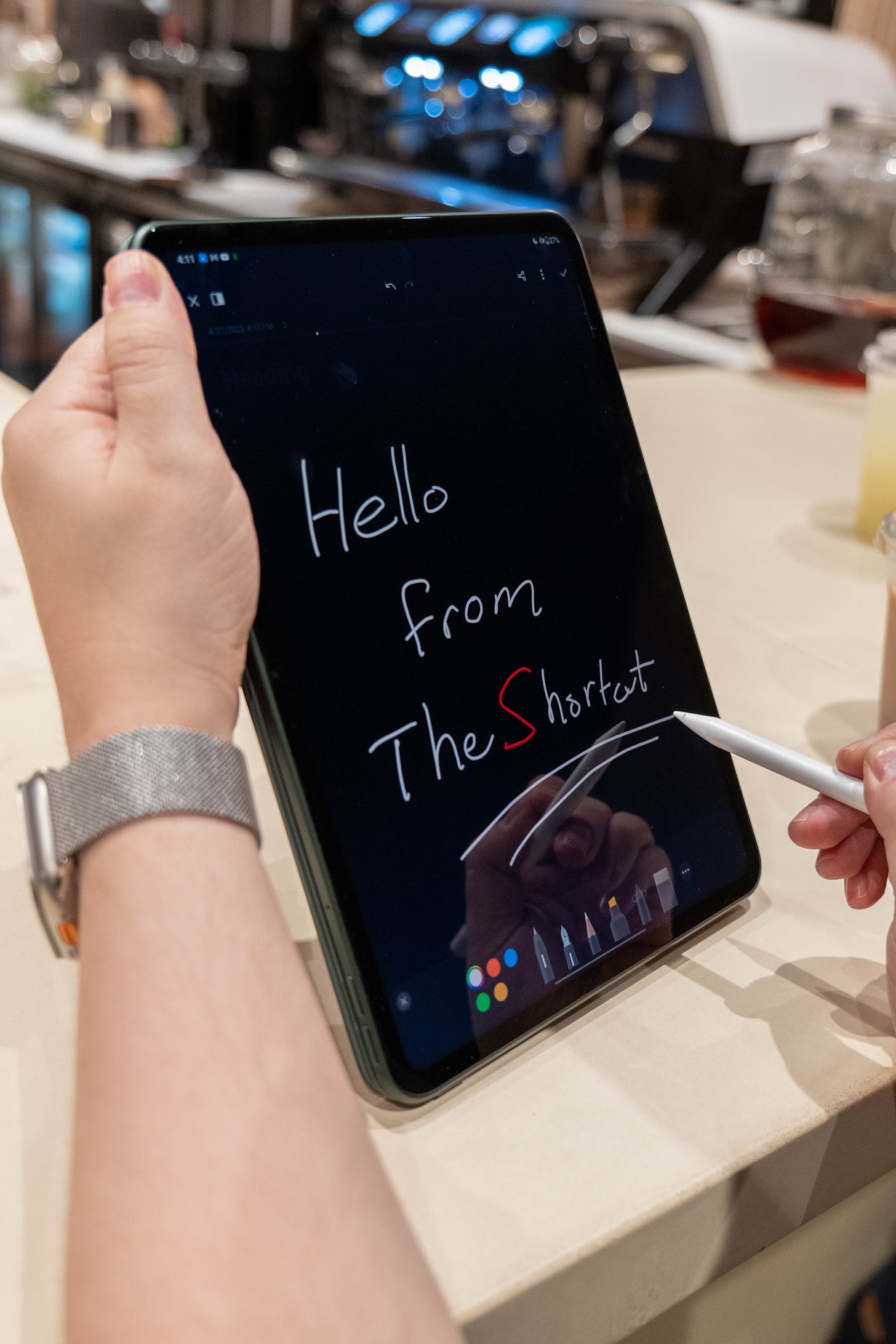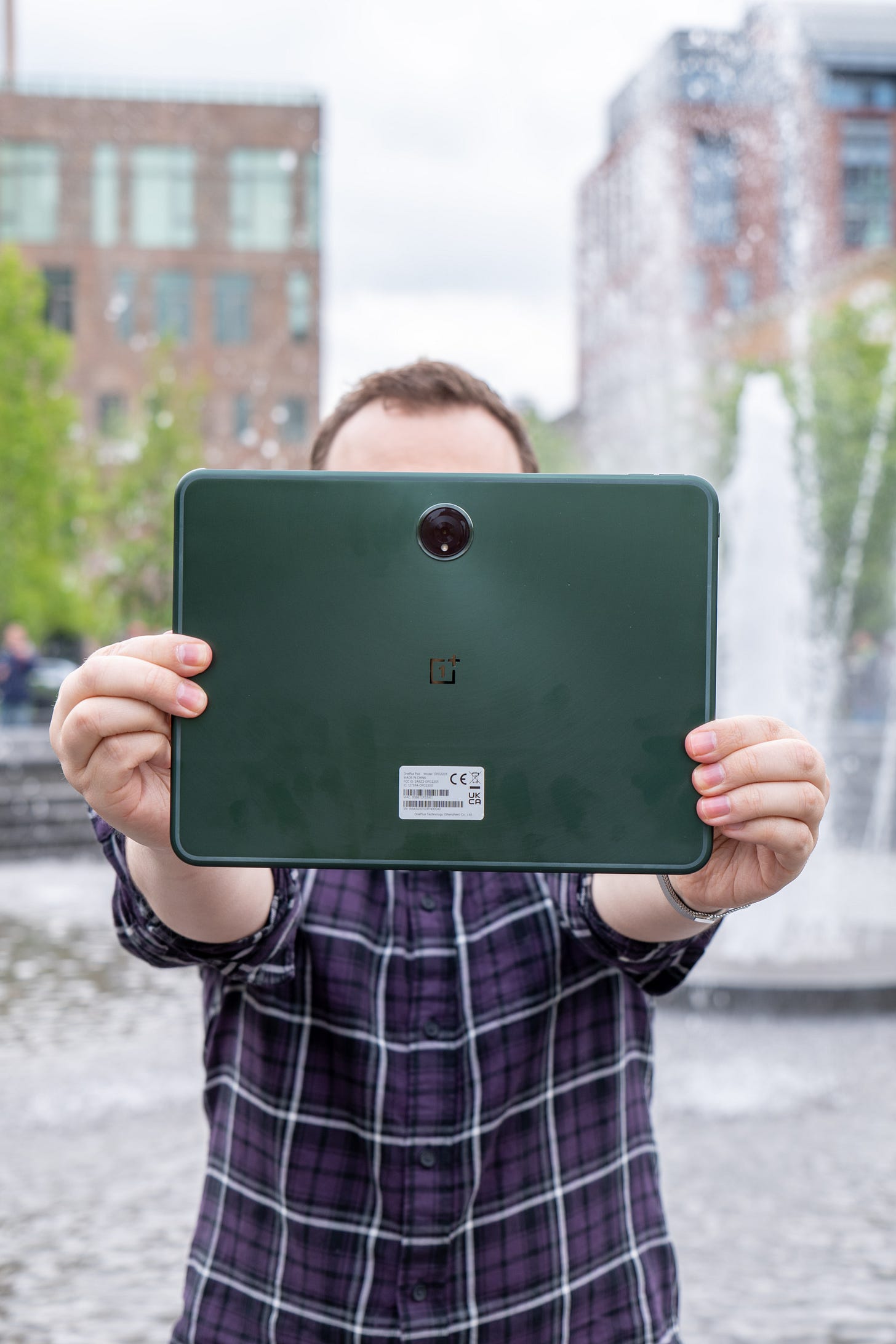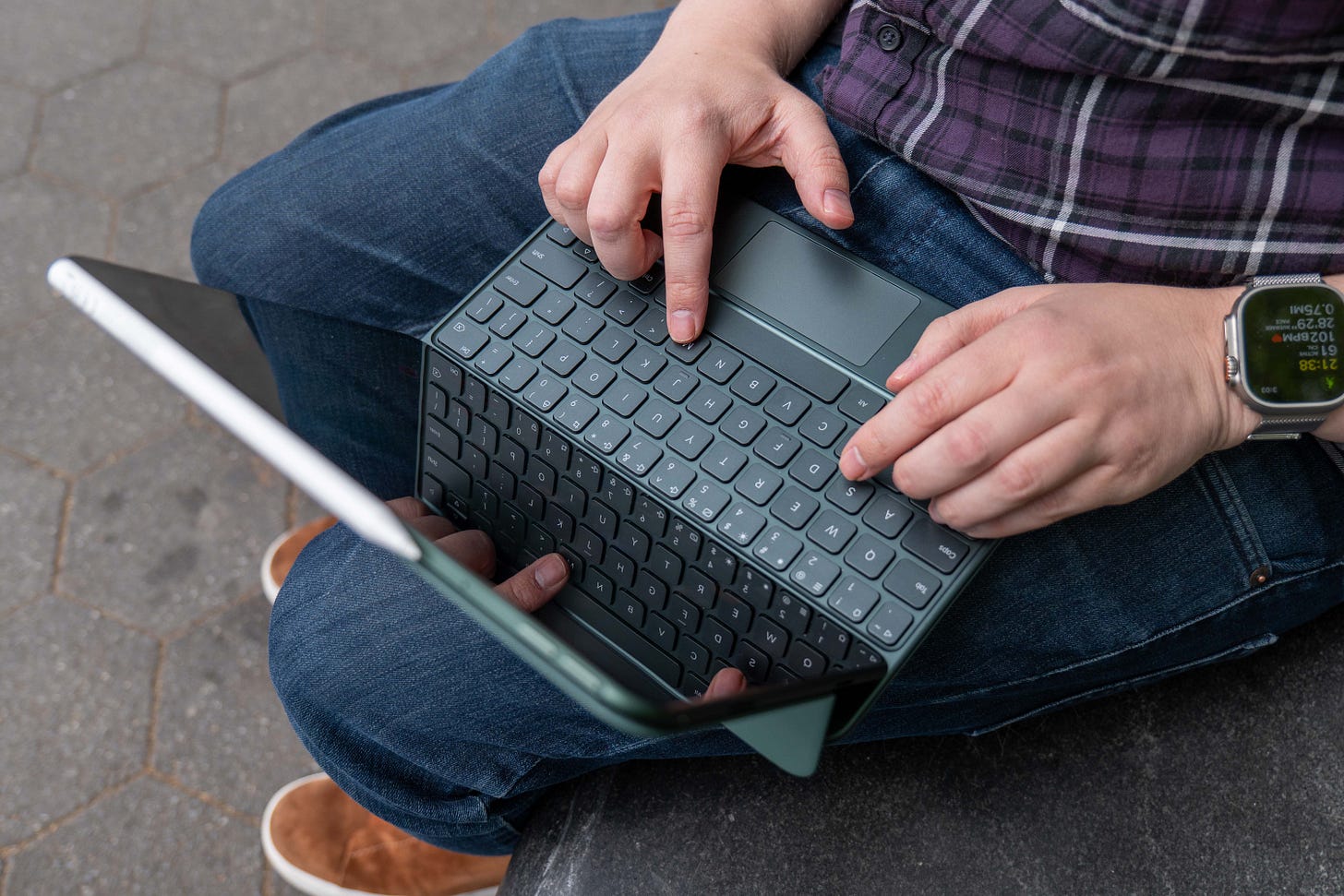OnePlus Pad review: $479 Android tablet that's a price-for-performance winner vs iPad
This 11.61-inch OnePlus tablet has a 144Hz screen refresh rate and double the storage of the basic Apple iPad
Review score: 4/5
🏆 Editor’s Choice Award
Pros
✅ 📱 $479 Android tablet that rivals the value of Apple’s iPad
✅ ⚙️ 128GB of storage and powerful Dimensity 9000 chipset
✅ 📺 Crisp 11.61-inch IPS display with fluid 144Hz refresh rate
✅ 🪄 Software tricks enable SIM-free data sharing, OTP auto-fill
Cons
❌ 🤔 Out-of-the-box settings require some fine-tuning
❌ 🌈 Just one color – you better like Halo Green
❌ 💳 No version with a SIM card
OnePlus Pad unboxing
In addition to the in-depth OnePlus Pad review below, I unboxed the new tablet on YouTube to show what’s in the box and along with the two accessories (sold separately): the OnePlus Magnetic Keyboard Folio and Stylos stylus. A full video review of the OnePlus Pad is coming soon in an update.
The Shortcut’s skinny review (3 min read)
Android tablets are mounting a comeback in 2023, and the new OnePlus Pad is eager to become the best value in their resurgence against the dominant Apple iPad. Google is going to steal headlines with the Pixel Tablet next month and Samsung launched a trio of Galaxy S8 tablets two months ago, but there’s a place for OnePlus, too.
At $479, the OnePlus Pad takes the company’s “Never Settle” motto and stretches it to fit a superb-looking 11.61-inch screen. Next to the iPad 10.9, this OnePlus tablet is bigger, more pixel-dense, offers a higher screen refresh rate and is more affordable when considering the storage specs and the significantly cheaper accessories.
The 144Hz variable refresh rate is the star here, giving the OnePlus Pad the biggest lead over the iPad 10.9 that’s stuck at a noticeably choppier 60Hz. OnePlus’ higher refresh rate means everything from games to scrolling is more fluid. You’ll have to upgrade to the significantly pricier iPad Pro to get that smooth screen perk.
Pound for pound, the new Pad matches or outperforms Apple’s basic iPad: having a superior screen-to-body ratio (though the borders are plenty thick for my liking), four speakers (instead of two), 128GB of storage (Apple starts at 64GB), and software tricks like easy cellular connectivity via your phone and One-Time Pass auto-filling.
It’s not all roses. Out-of-the-box settings required me to turn on many of this tablet’s best features (and turn off the on-screen keyboard when, annoyingly, already using the Magnetic Keyboard Folio). By fine-tuning this clearly first-gen product, I was able to bypass software hijinks that may also frustrate other reviewers.
I couldn’t fix the fact that there’s only one color – you better like Halo Green if you’re buying this tablet – and it lacks a SIM card slot. OnePlus’ “easy cellular connectivity” is a fix for some… if you own a OnePlus phone. But it’ll drain your phone’s battery life faster than if there was a dedicated SIM card inside this tablet.
I also wish the OnePlus Magentic Keyboard was backlit and tilted at varying angles. Sure, Apple’s official Magic Keyboard is $100 more and isn’t backlit either, but there are third-party iPad keyboards that are. I don’t think the OnePlus Pad is going to get the same treatment of endless variety from random accessory makers. Luckily, I loved the pressure-sensitive OnePlus Stylo pen that can magnetically cling to the Pad’s frame (Apple Pencil Gen 1 can’t this, but the Gen 2 can… on higher-priced iPads).
And that’s the big picture: you get a handful of pro-level features at a basic price. The OnePlus Pad is $479 and seemingly more expensive than the iPad 10.9 at $449. I was surprised when I saw the news myself. But then, diving into the specs, I realized that the entry-level iPad has an underwhelming 64GB of storage when the sole OnePlus Pad configuration is 128GB. The 256GB iPad 10.9 jumps to $600, $120 more. In other words, the Pad does OnePlus does better: finding a middle ground on price vs specs.
As I suggested in the OnePlus 11 review in February, OnePlus is the best-positioned Android manufacturer for consumers facing a tough economy. The new OnePlus Pad extends OnePlus’ lead in the value-for-performance game.
OnePlus Pad specs
💰 Price: $479
📺 Screen size: 11.61-inch (7:5 aspect ratio)
🖥️ Resolution: 2800 x 2000 IPS LCD with Dolby Vision
🏃♂️ Refresh rate: 144Hz
💡 Brightness: 500 nits
📸 Camera (rear): 13MP
🤳 Camera (front): 8MP
⚙️ Chipset: MediaTek Dimensity 9000
🐏 RAM: 8GB (LPDDR5)
🗄️ Storage: 128GB (UFS 3.1)
🔈 Speakers: 4 stereo
🔋 Battery: 9,510mAh
🔌 Charger: 67W SuperVooc (included)
📶 Connectivity: WiFi 6, Cellular Data Sharing
👇 Fingerprint sensor: No
📐 Dimensions: 258.02 x 189.41 x 6.54mm
⚖️ Weight: 555g (1.22lbs)
🌈 Colors: Halo Green
🤖 OS: Android 13.1, Oxygen 13.1
⌨️ Keyboard: OnePlus Magnetic Keyboard
🖋️ Stylus: OnePlus Stylo
OnePlus Pad review in-depth
OnePlus Pad price
💰 Value prop. It’s $479 with one size and one color option: 128GB of storage and in Halo Green. To get the full experience, though, you’ll end up shelling out $99 for the OnePlus Stylo (the official stylus) and $149 for the OnePlus Magentic Keyboard. But they’re still cheaper than what Apple charges for its accessories: $120 for its Apple Pencil 2nd gen and $250 for its Magic Keyboard Folio.
🤼 Rivals iPad 10.9 on price. For $30 less, you could buy the iPad 10.9 instead, and I still think an iPad is the better choice for iPhone owners. That said, I can’t really recommend a 64GB iPad to most people, and the next level up, iPad 10.2 256GB, is $600. So OnePlus is the better value among tablets – if you’re an Android owner.
OnePlus Pad design
🛡️ Armored in metal. During my testing, the OnePlus Pad’s unified metal body felt as sturdy as an iPad and sported curved edges on the back with a flat front. It’s thin with a slimmer profile than the basic iPad (6.54mm vs Apple’s 7mm), but it may be difficult to keep a low profile with this one. Its center-aligned rear camera is big and obvious, and because it peeks out through the folio, it was deemed “a bit creepy” by a friend while I was at a restaurant. Lesson learned: the less pronounced rear cameras are on a tablet while working in public the better.
🪖 Halo Green with fingerprints. There’s only one color – Halo Green – and lucky for OnePlus, it’s very likable. It also matches the OnePlus 11’s attractive Eternal Green color, though the Pad is more of a fingerprint magnet (as you’ll see in some of our review photos). That won’t matter if you spring for the keyboard folio, though.
OnePlus Pad accessories
⌨️ Attracted to the Magnetic Keyboard. No, it doesn’t come with the tablet (that’s the first question a couple of people asked me on social media), but if you’re keen on being productive with the OnePlus Pad, then the $150 magnetic keyboard is almost essential for productivity. Good news: it comes with full-sized laptop-like keys with function keys and a small, but reliable trackpad with support for gesture. Best of all, it doesn’t require charging or Bluetooth (there’s a three-point pogo pin for an easy connection), feels leather-like (so not quite leather but feels like it) and remains lightweight, so it doesn’t add to the 552g weight of the OnePlus Pad.
🖋️ Locked-in OnePlus Stylo. This is the OnePlus tablet’s stylus, and the hardware works just as well as the pricier Apple Pencil 2nd gen. It magnetically clings to the OnePlus Pad’s frame – although in a slightly confusing decision, it attaches off-center. No matter, it has 4096 levels of pressure and 2ms low delay. The one problem I had with the $99 OnePlus Pad stylus is the same issue I have with Samsung’s S Pen: software. Again, the default notes app is locked to the tablet, making it less useful for pulling up your notes on a computer later on.
OnePlus Pad display and speakers
🏃♂️ Speedy 144Hz refresh rate. The screen is where this tablet shines, with a fast 144Hz refresh rate that’s more than double what you’ll get on the basic iPad. This means everything from gaming to scrolling through Instagram looks less choppy compared to the 60Hz we see from Apple (except for the Pro models). I also like the 7:4 aspect ratio which feels more natural for reading and tackling spreadsheets.
🖼️ Slim bezels. OnePlus pushes the display as far as it can go to the edges with a 88.14% screen-to-body ratio. I felt like it still has noticeable bezels, but when I looked back at the iPad, it beat every one of its Apple challengers.
🔈 Play it loud: Maybe the most surprising A/V peak to buying the OnePlus Pad over the basic iPad is that it had four speakers instead of two, a feature ripped from its pricier iPad Pro and Galaxy Tab S8 competitors. Even in the noisy outdoor environments of NYC, I was able to hear audio from the quad-speaker system.
OnePlus Pad performance
🗄️ Storage wars. 128GB is the right size for a tablet for most people, so the OnePlus gets it right and it’s about time Apple sunsets the 64GB iPad. No one wants the threat of a “Storage Almost Full” message constantly popping up. Sadly, there’s no microSD card slot on this tablet, something you’ll get on the more expensive Samsung Galaxy Tab S8, which also starts at 128GB.
⚙️ Chippy performance. The use of the MediaTek Dimensity 9000 chipset is a major upset to OnePlus’ usual pick of Qualcomm’s Snapdragon processors. And good news, the performance of the OnePlus Pad keeps up from what you’d expect from a tablet – including iPads in this class. I found no major slowdown from opening up multiple apps and using OnePlus’ split-screen functionality. You won’t get the fastest video exporting or high-end gaming at the full 144Hz for 3D games, but it’s no slouch.
OnePlus Pad battery life
🔋 Stand by me. The OnePlus Pad can last a full month in standby mode, which is pretty incredible. I wasn’t able to fully test that out in my two weeks with this thing (I had to actually use the tablet), but I can tell you that the 9,510mAh battery capacity lasted me all day in real-world usage and when I had the tablet idling overnight, the percentage would hardly budge.
🔌 Charles OnePlus in charge. Even with the battery did deplete, I found the 67W SuperVooc charger that’s included in the box to be fast – for a tablet. It doesn’t have the same wow effect as charging a phone in under an hour (tablet batteries are almost twice as large), but I was pleased to be able to charge this thing in full in about 90 minutes.
Should I buy the OnePlus Pad?
Yes, if…
✅ You want a tablet under $500 that has 128GB of storage
✅ You want an Android tablet to go with your OnePlus phone
✅ You think that a 144Hz refresh rate is far superior to 60Hz
No, if…
❌ You have an iPhone and aren’t thinking about switching ecosystems
❌ You need to have a keyboard that is backlit in dark environments
❌ You need a cellular-connected tablet and don’t want to drain your phone




